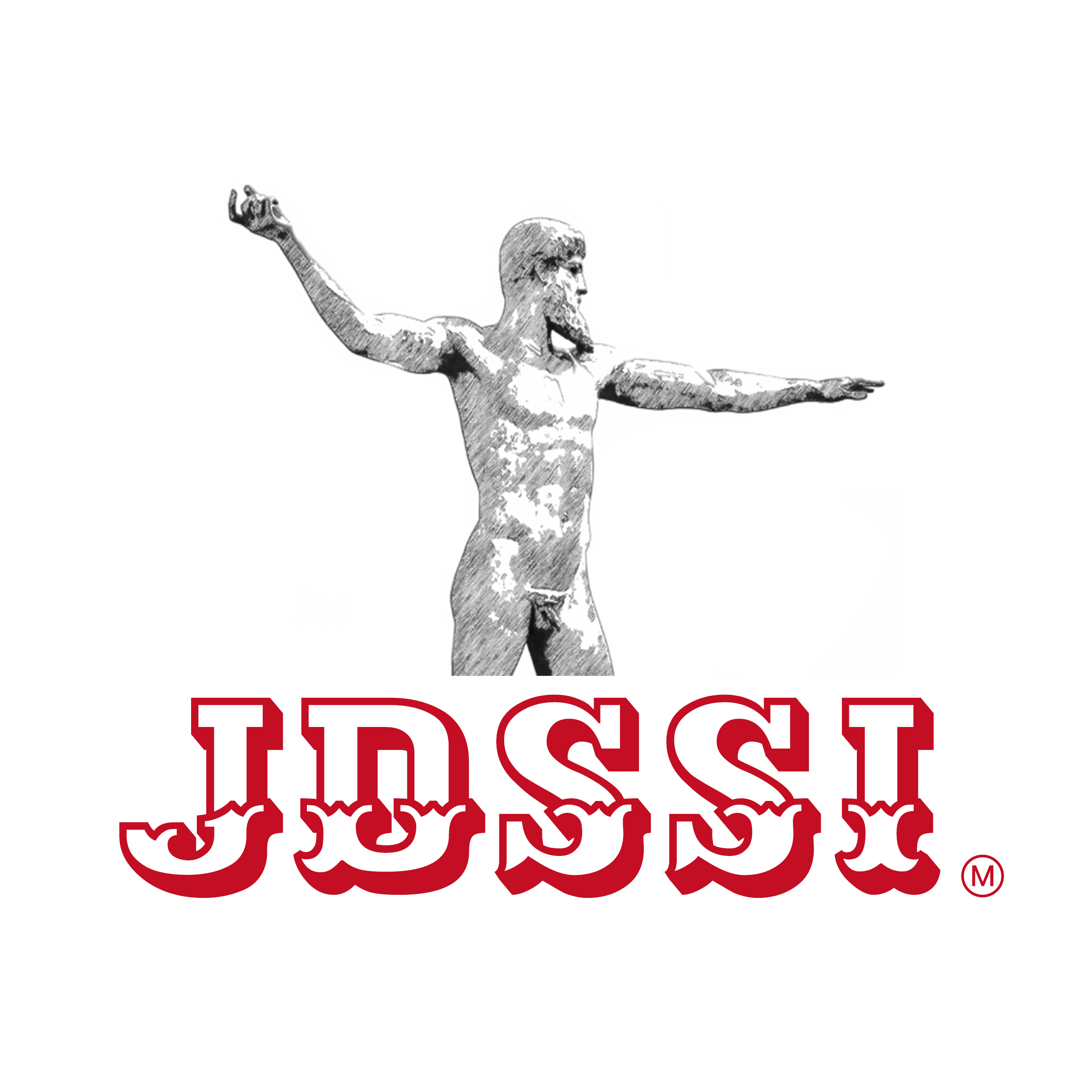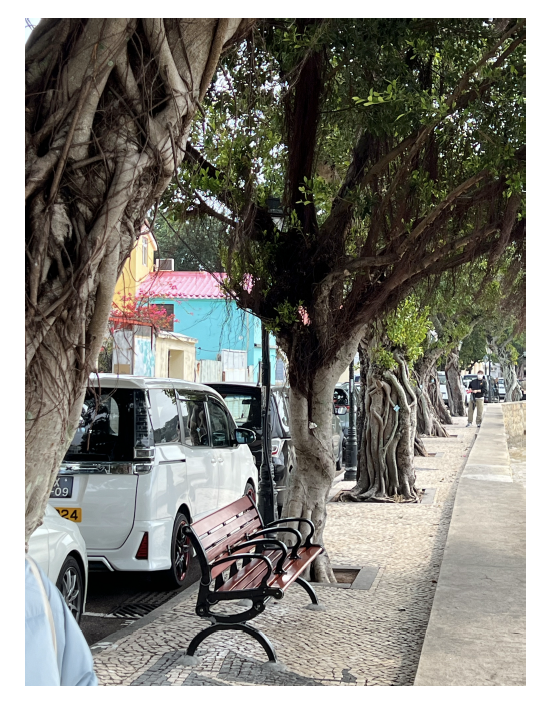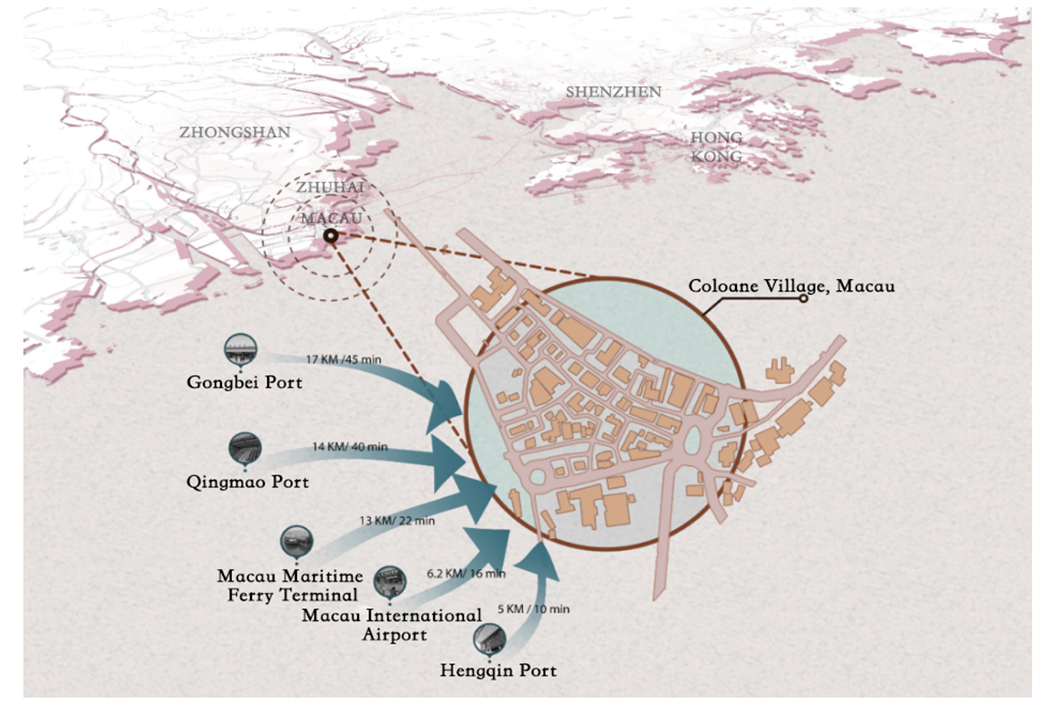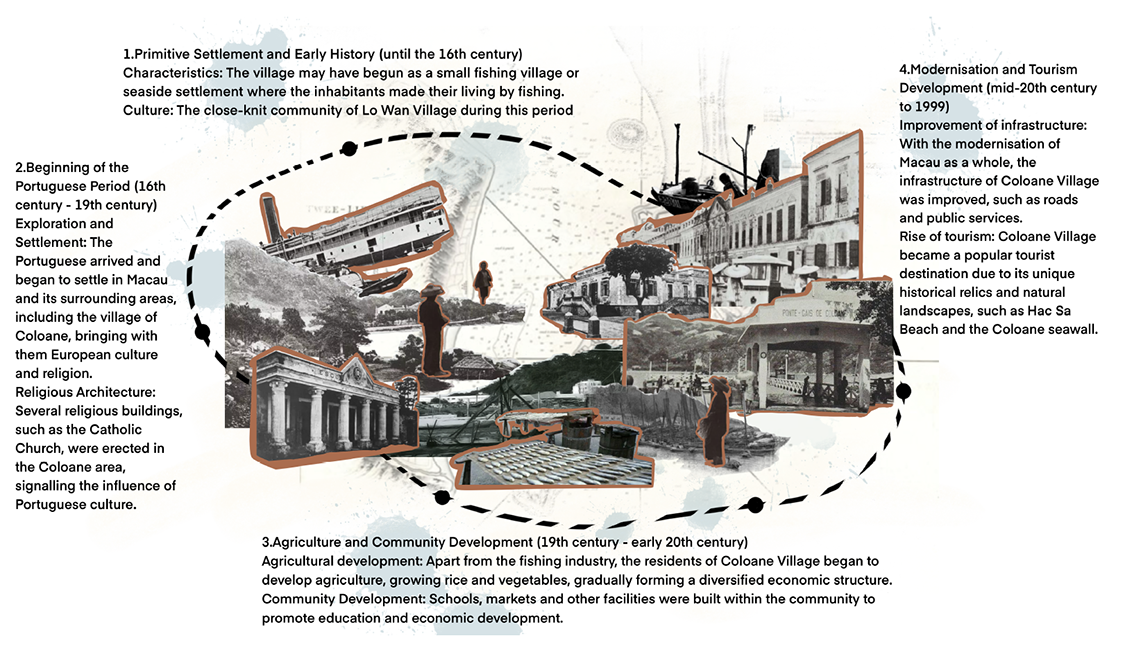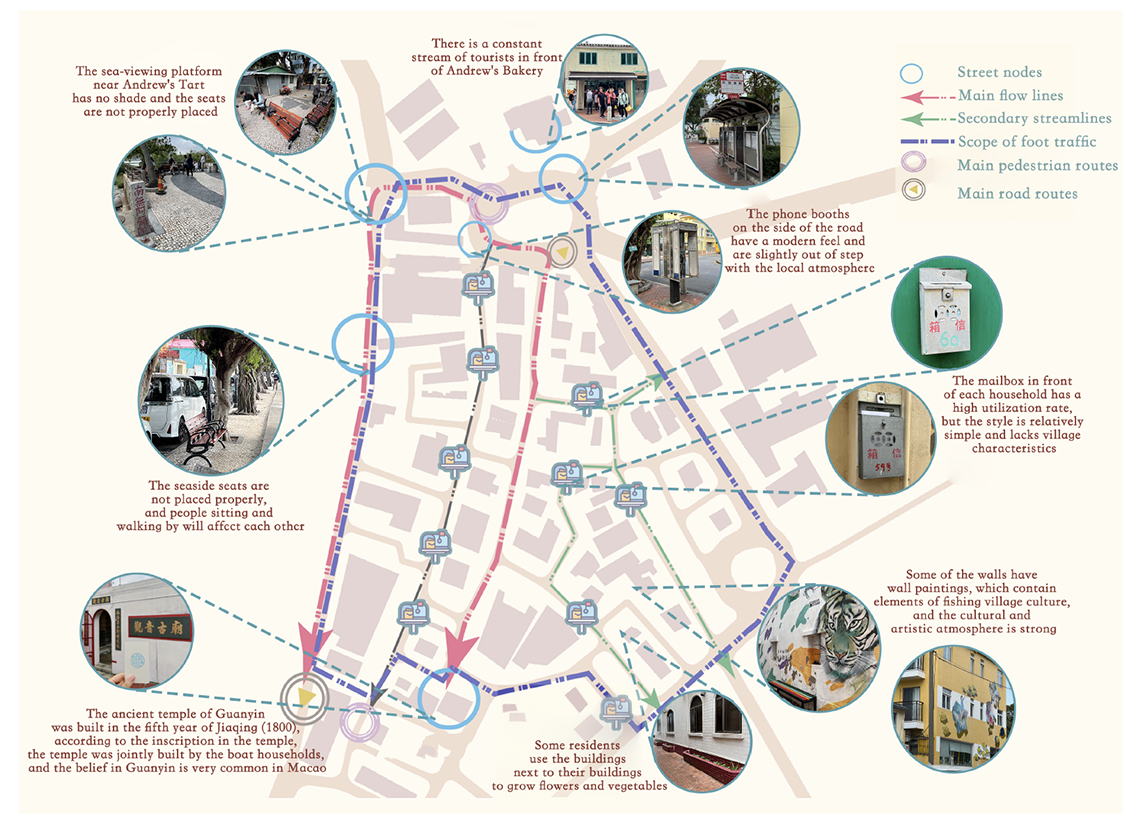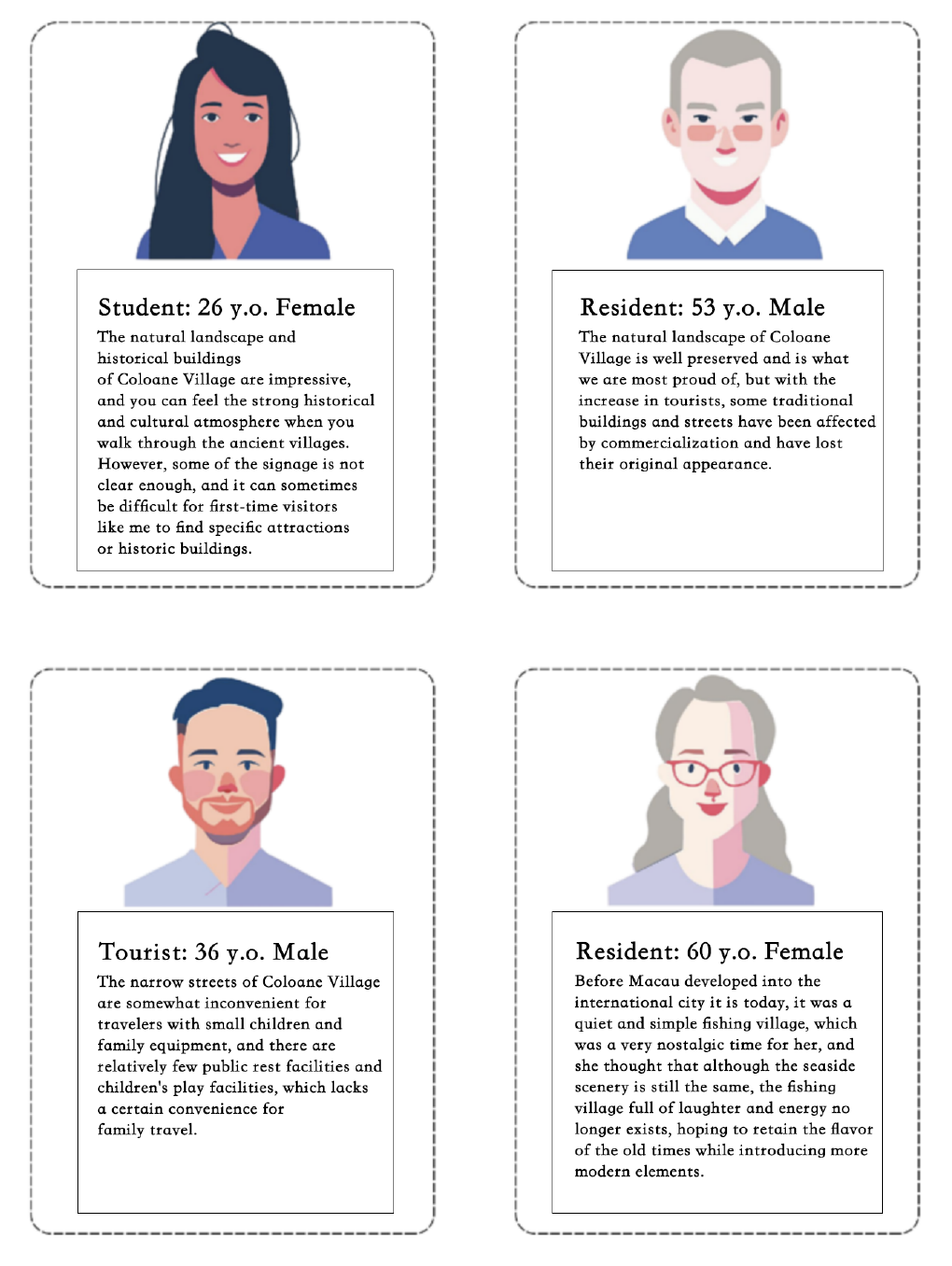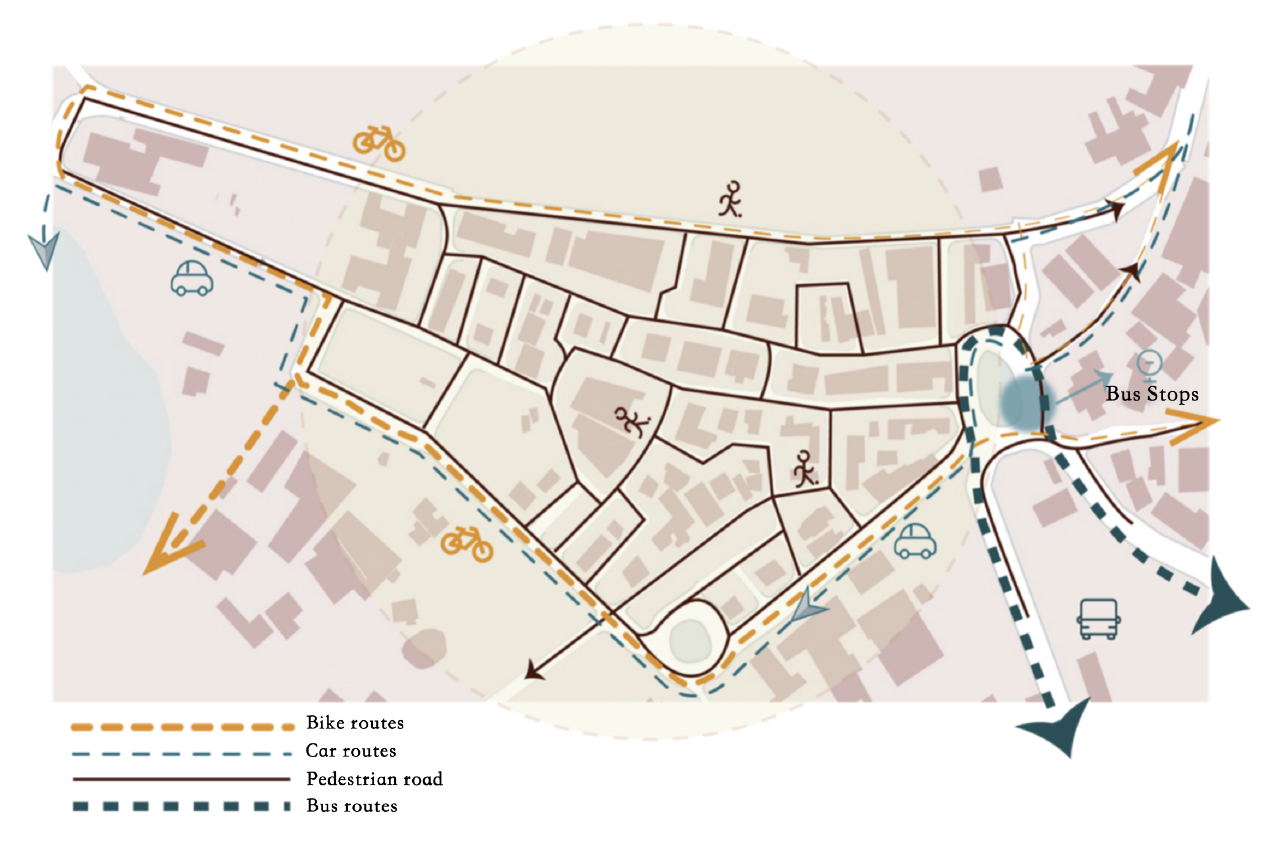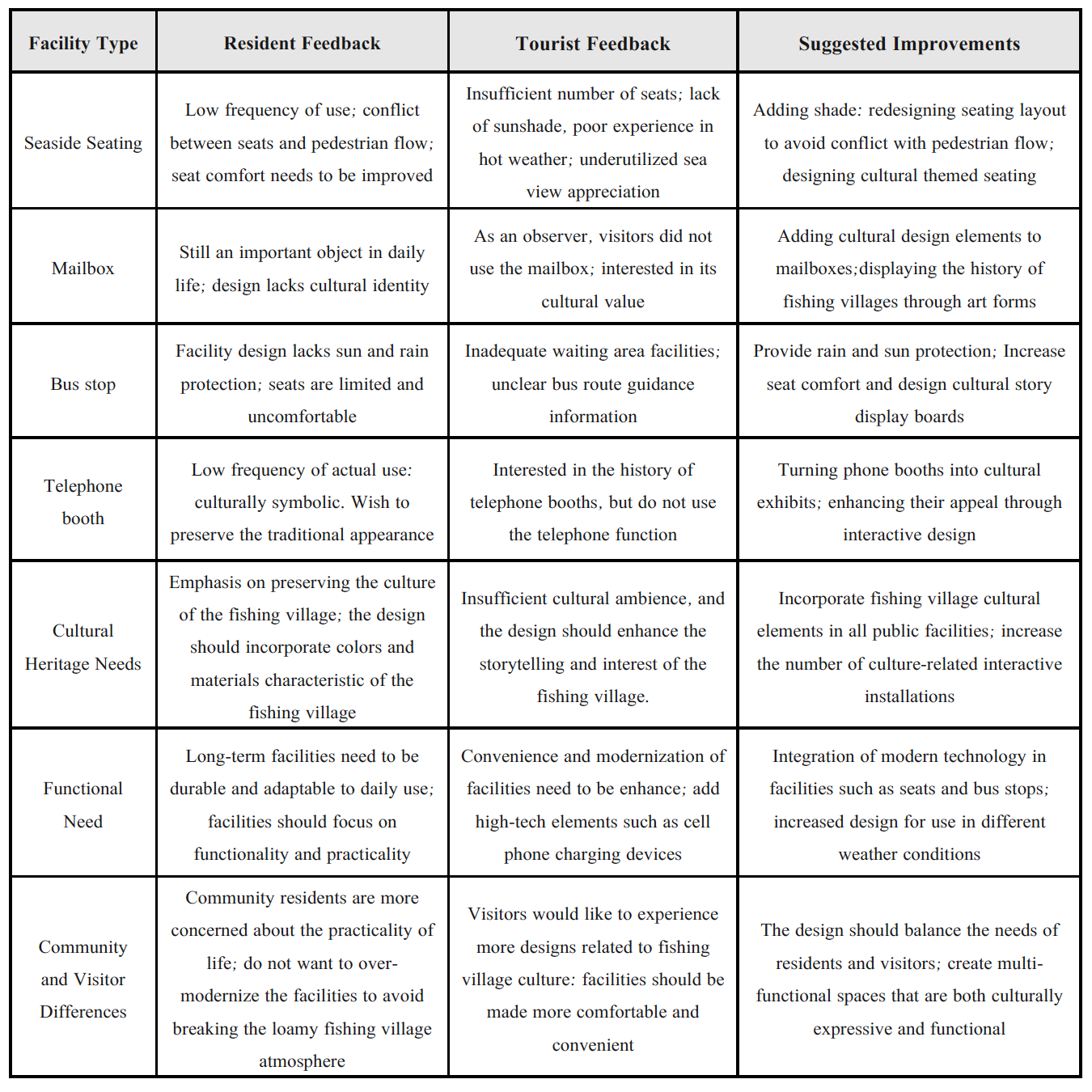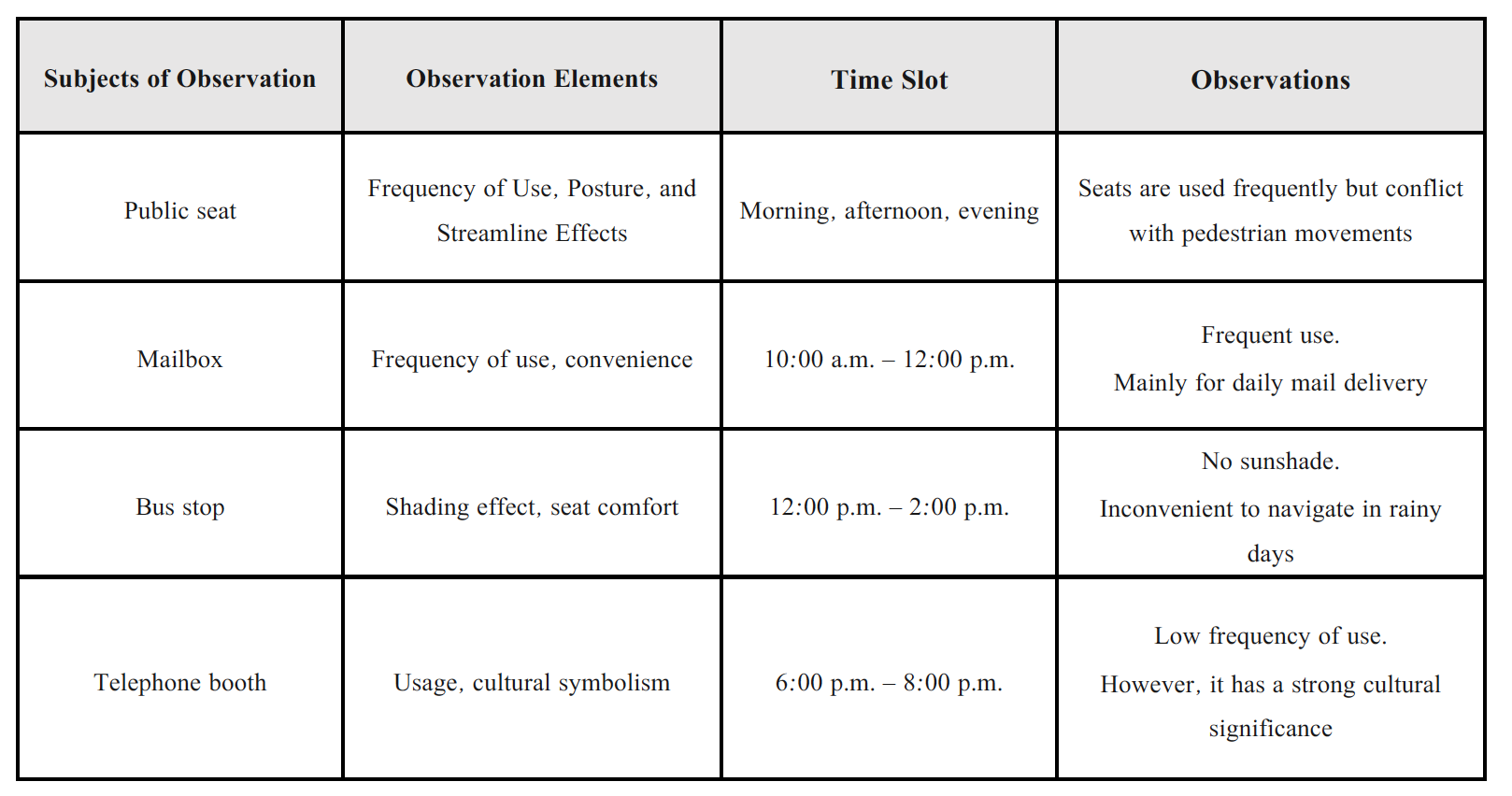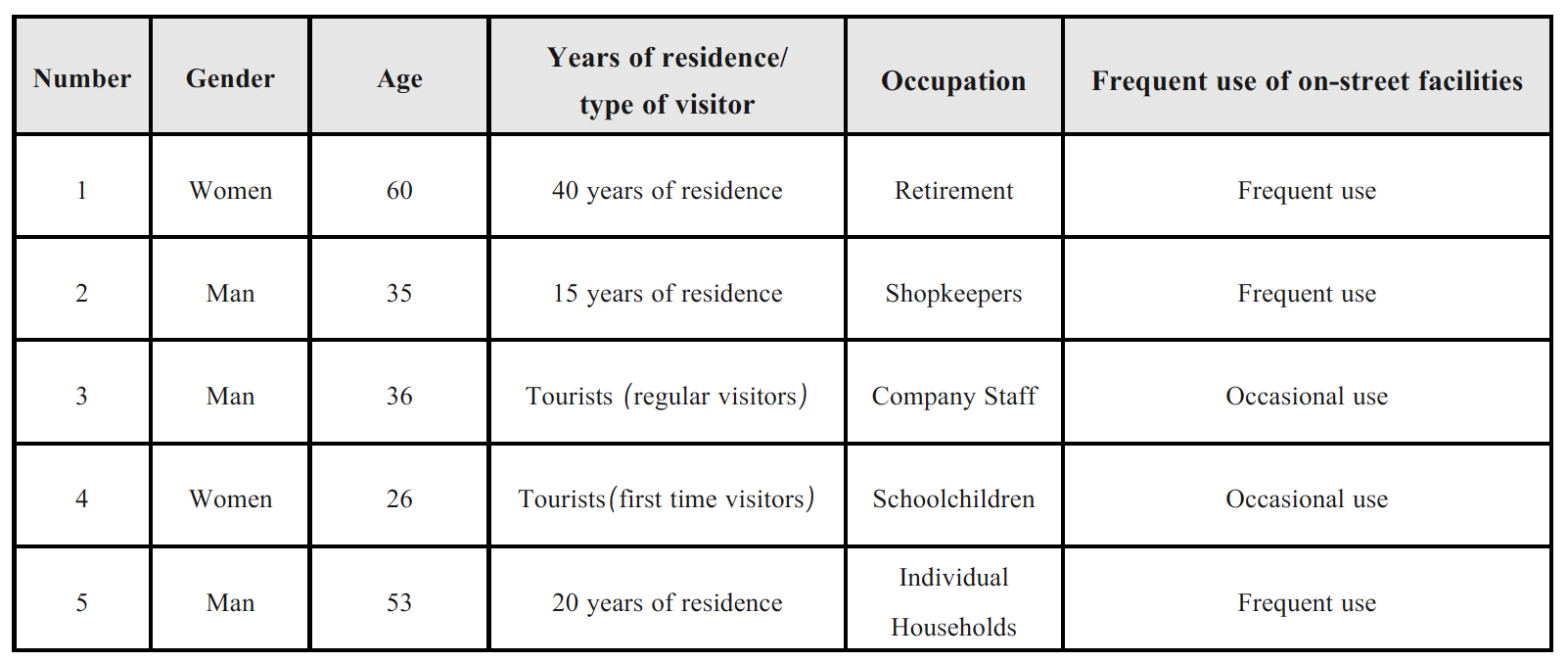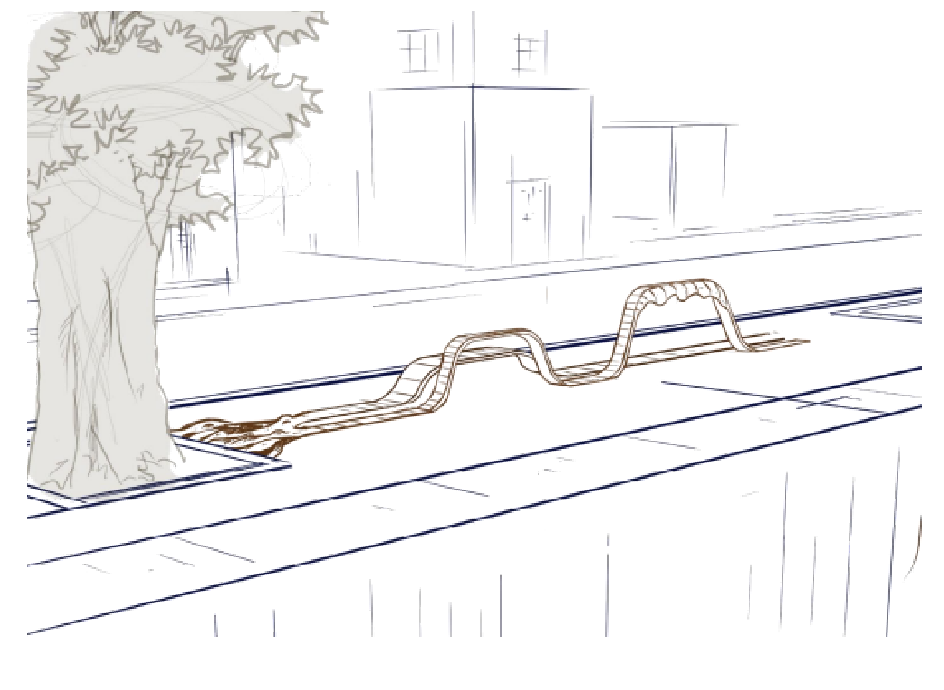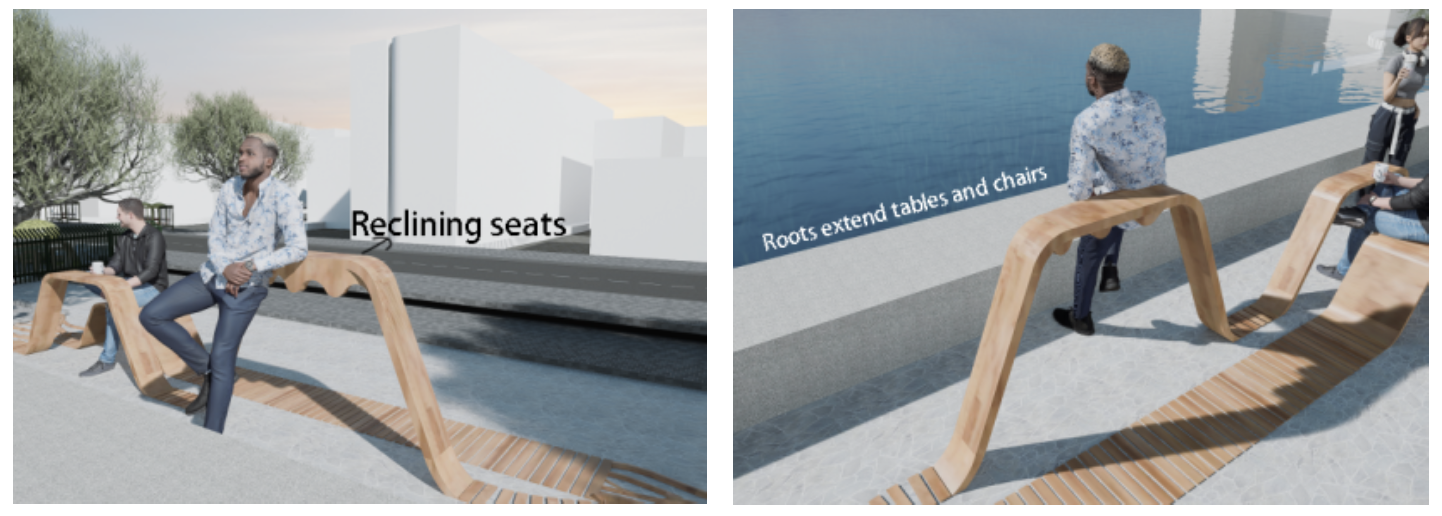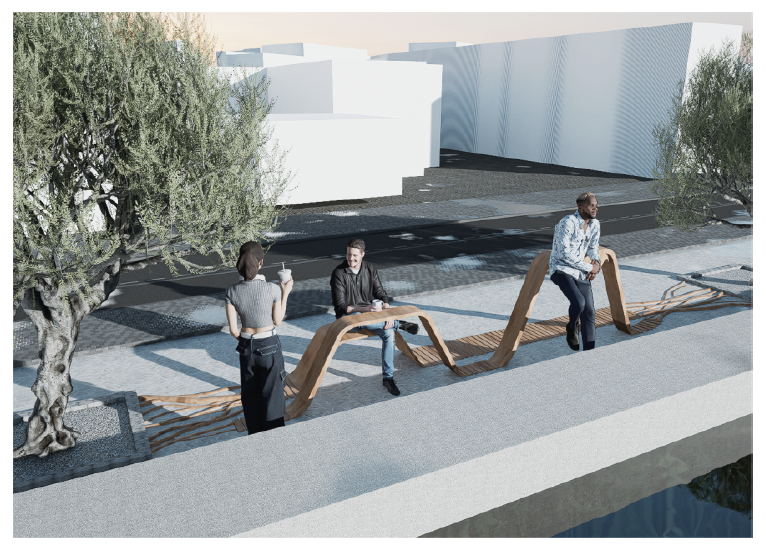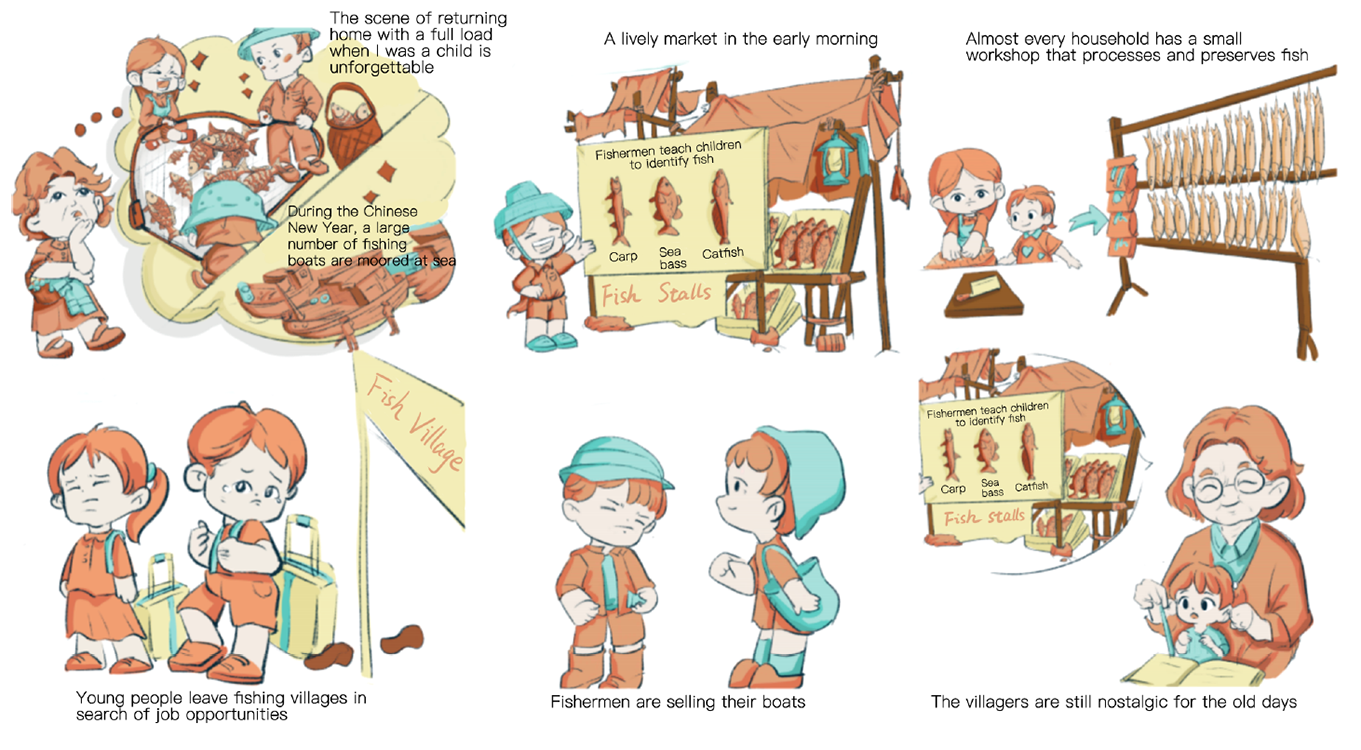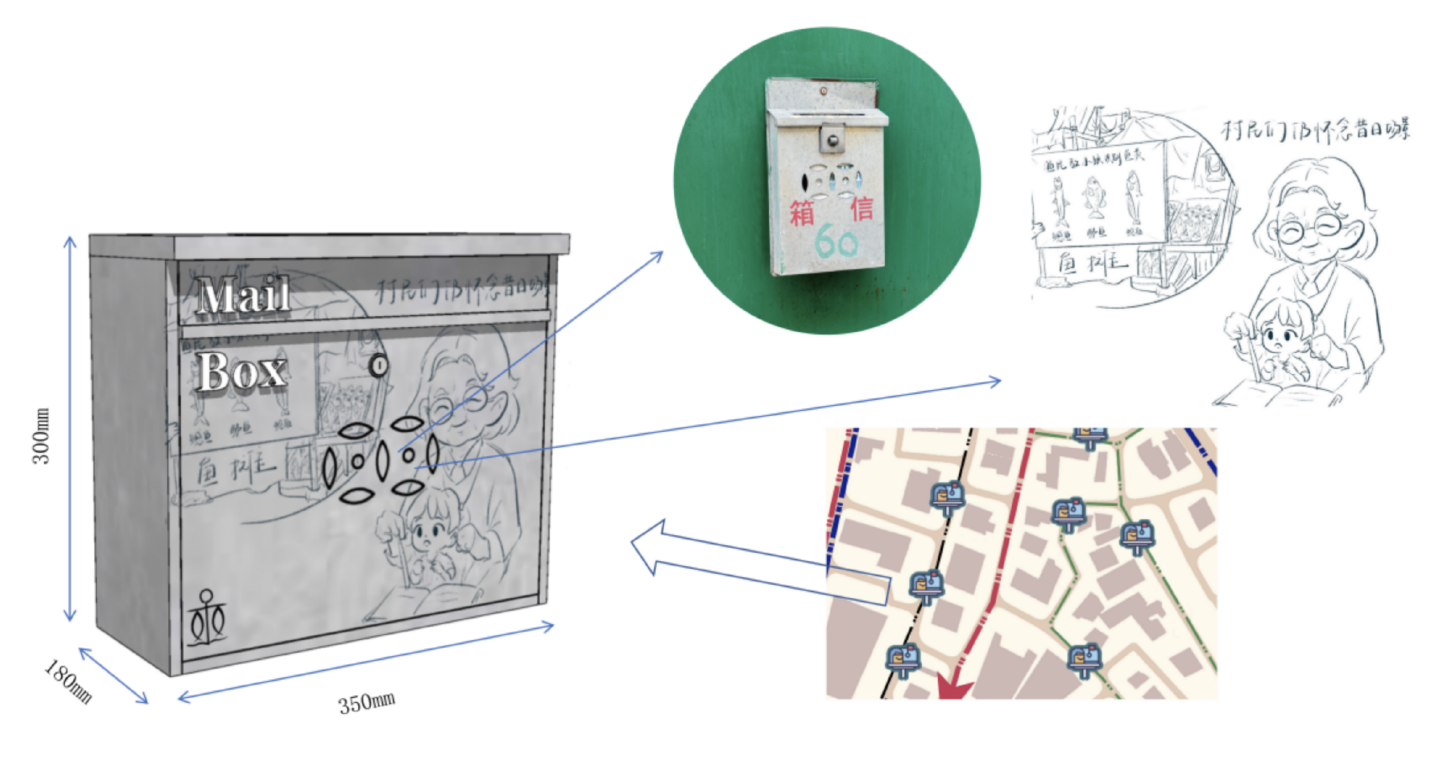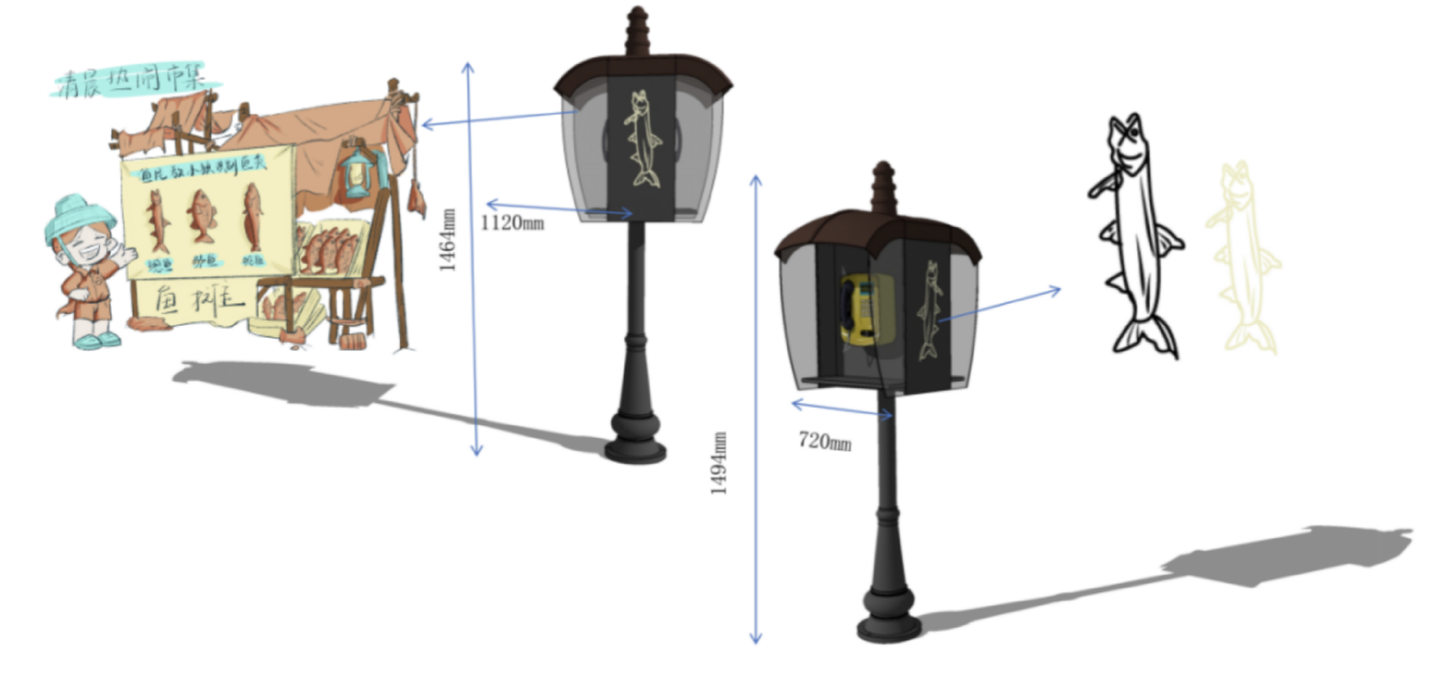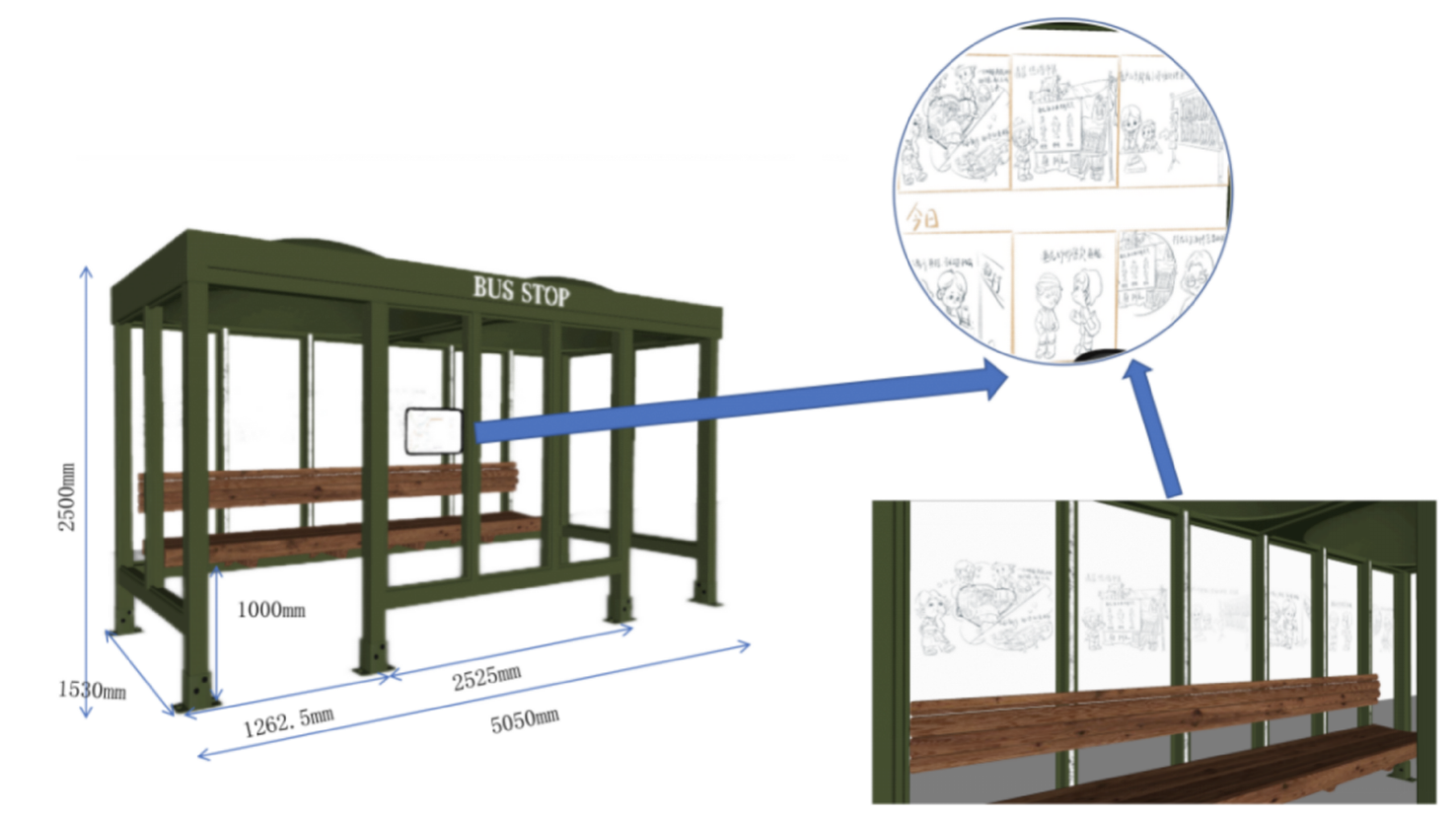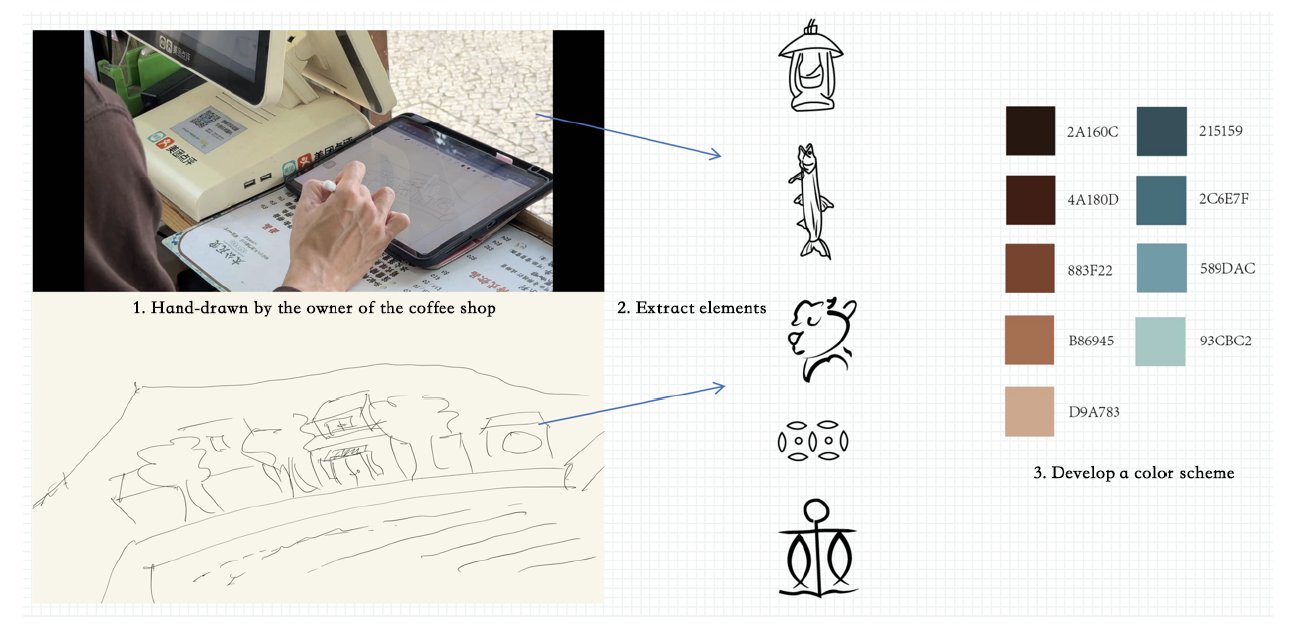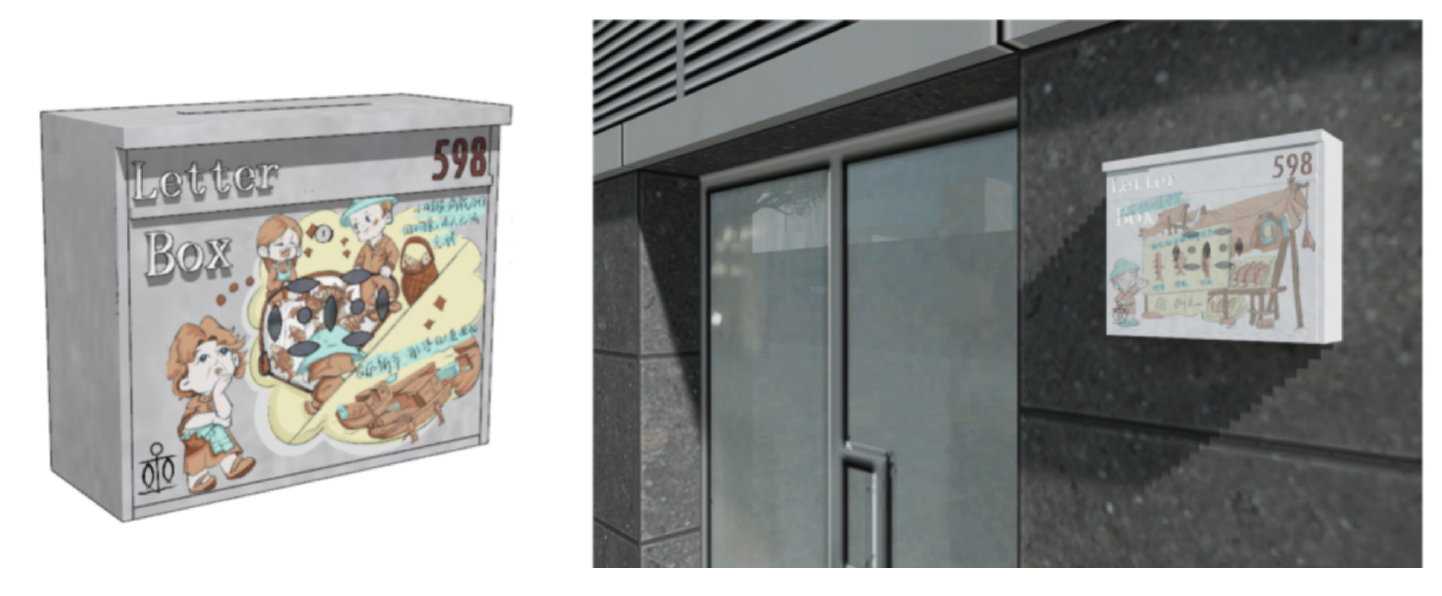Share and Cite
Chicago/Turabian Style
Linzi Yu, and Xin Hu, "A Study on the Design Strategies for Micro-Renewal of Street Side Installations in Coloane Village, Macao." JDSSI 3, no.1 (2025): 19-44.
AMA Style
Yu LZ, Hu X. A Study on the Design Strategies for Micro-Renewal of Street Side Installations in Coloane Village, Macao. JDSSI. 2025; 3(1): 19-44.
© 2025 by the authors. Published by Michelangelo-scholar Publishing Ltd.
This article is published under the Creative Commons Attribution-NonCommercial-NoDerivs 4.0 International (CC BY-NC-ND, version 4.0) license (https://creativecommons.org/licenses/by-nc-nd/4.0/), which permits non-commercial use, distribution, and reproduction in any medium, provided the original work is properly cited and not modified in any way.
3.4. Traffic Analysis
Figure 3 shows the traffic analysis with yellow dotted lines representing cycle routes, blue dotted lines representing car routes, brown dotted lines representing pedestrian routes and dark green dotted lines representing bus routes. The traffic in the inner village of the ring road is mainly represented by the internal roads which are winding and dense and can only be relied on for walking. Public transport does not have access to the inner village and cyclists and cars can only travel around the outer ring. Pedestrian paths may be too narrow or obstructed by other facilities, which may reduce the comfort and convenience of pedestrian movement. There may also be some safety concerns if there is a lack of adequate separation between the footpaths and other traffic areas.
A Study on the Design Strategies for Micro-Renewal of Street Side Installations in Coloane Village, Macao
2. Literature Exploration
2.1. Theoretical Framework for Micro-Renewal
Micro-renovation, or Tactical Urbanism, as a strategy for the progressive renewal of urban space, has attracted much attention both domestically and internationally in recent years. As an important stock in urban construction and development, promoting the transformation of old neighborhoods is an important means of improving the utilization of stock resources [4]. Xing et al. 2022 note that with societal changes, there has been a shift in the understanding of community. The spatial transformation of old neighborhoods no longer relies on functional upgrading or environmental beautification, but rather needs a redefinition of the contemporary meaning of these neighborhoods [5]. As China’s ageing process accelerates, social problems are becoming increasingly prominent. Ageing-appropriate renovation from the perspective of stock renewal for older communities in cities with a high proportion of elderly people, seriously ageing infrastructure and a lack of space and facilities for activities for the elderly can not only mitigate the negative impacts faced by the elderly in terms of changes in their physiology, psychology and social relationships, but also promote the sustainable development of diversified healthy ageing communities in cities [6]. This is in line with the objectives of the micro-regeneration of Coloane Village in Macau, which aims to preserve the unique culture of the traditional fishing village while injecting new vitality into the community through design strategies.
In 2024, Li Yun-sun further suggests that China’s urban development has shifted from “incremental development” to “stock adjustment,” and that urban regeneration has gradually become mainstream. This means that urban regeneration is no longer about the development of new areas, but rather the enhancement of the functional and cultural values of existing spaces through micro-regeneration [7]. This theory is particularly valuable in the case of Coloane Village in Macau. As a fishing village with a long history, the micro-regeneration design of Coloane Village should adhere to the principle of minimal intervention, avoiding excessive modernisation while emphasizing the preservation of cultural heritage.
Micro-regeneration as a strategy is receiving increasing attention, especially in the context of China’s rapid urbanisation. It aims to improve urban functions and enhance community characteristics through small-scale, decentralised projects, rather than large-scale urban renovation, while minimizing resource consumption and environmental impact. Micro-regeneration is also an important direction in urban renewal and sustainable development strategies abroad, especially in Europe and the United States.
Table of Contents
- Abstract
- Introduction
- Literature Exploration
- Preliminary Research
- Research Methods
- Design Programme
- Discussion
- Conclusions
- Author Contributions
- Funding
- Acknowledgements
- Conflicts of Interest
- Author Biographies
- References
1. Introduction
Coloane Village, one of the two islands of Macau, is situated in the southern part of the city, across the sea from the Hengqin New Area in Zhuhai. The economy of the village of Luwan is relatively slow, but the fishing industry is more developed, which used to be the mainstay of the village, but shipbuilding used to be the mainstay of the village as well [1]. This century-old fishing village is famous for its tranquil sea-village atmosphere and beautiful natural scenery. However, with the rapid development of modern industries, the unique features and cultural characteristics of Luhuan Village are gradually being eroded, and the traditional fishing economy is gradually being replaced by tourism and other new industries, and the traditional characteristics of the village are in danger of disappearing. In fact, a traditional village should not simply be treated as a tourist landscape, but should be built into a villager-centered, sustainable production and living space [2].
The protection and development of traditional villages is getting more and more attention from people from all walks of life [3]. Against this background, the question of how to protect and pass on the cultural heritage of Lu Wan Village while promoting its modernisation has become an urgent issue. By exploring the micro-renewal strategy, this study aims to preserve the unique features of the traditional fishing village and inject new vitality into it through the subtle modification of the streetside facilities in Coloane Village. Micro-renewal (also known as micro-renovation or tactical urbanism) is a strategy aimed at improving urban functions and enhancing community characteristics through small-scale, incremental renewal techniques. Compared to large-scale urban renewal, micro-renewal is more resource-efficient and environmentally friendly, while also offering greater flexibility in adapting to the needs of community residents.
4. Research Methods
4.1. User Observation Method
4.1.1. Research Objectives
The study aims to gain insights into the behaviour and needs of the residents and visitors of Coloane Village in Macau in terms of street-side public facilities. Through the user observation method, the research specifically focuses on how they use street-side installations (e.g., seats, mailboxes, telephone booths, and bus stops) within the context of the fishing village culture. By observing different groups of people, problems in the design and opportunities for improvement are identified to inform the micro-renewal design.
4.1.2. Observation Content and Problem Orientation
(A) Use of Public Seats
Observations: The study observed how often residents and visitors use the seafront seats, how they interact with the seats, and how they engage with their surroundings.
Problem orientation: The study assessed whether the seats meet the needs of both residents and visitors. It also identified any inconveniences related to their use, such as layout or design issues, including potential disturbances to pedestrians, accessibility concerns, or discomfort.
(B) Functionality and Frequency of Use of Mailboxes
Observation: The study recorded the daily use of letterboxes by residents, especially in the context of new communication methods brought about by technological development. It explored whether letterboxes still play an important role.
Problem Orientation: The study explored whether the existing mailbox design meets the needs of modern life and whether it needs to be updated with new elements.
(C) Comfort and Functionality of Bus Stations
Observation: The study observed the ability of bus stops to serve residents and tourists under different weather conditions (e.g., sun exposure, rain), including the use of waiting seats and the legibility of the guidance system.
Question Orientation: The study explored whether the design of the station sufficiently takes into account the climatic conditions of Macau. It also explored how the waiting experience can be enhanced through the design?
(D) Culturality and utilisation of telephone booths
Observation: The study observed the actual use of telephone booths, especially in the context of the popularity of mobile communication, with the aim to determine whether there is still a certain demand for their use and their cultural symbolic role as street-side installations.
Problem orientation: The study explored whether telephone booths are still functional and how can their cultural symbolism be enhanced through renovation to make them compatible with the modern environment?
4.1.3. Observation Elements
Behaviour: this entails movements, postures, length of time people spend using the street furniture, and the way they interact with it.
Space utilisation: This involves observation of the relationship between the street furniture and the surrounding environment, such as pedestrian flow, accessibility and ease of use of the facilities.
Climatic impacts: the use of public facilities under different weather conditions (e.g. sunny, rainy, hot weather).
Interactivity: This involves observing the frequency and nature of interactions between residents and visitors, or between people and facilities; e.g. whether people actively share the seating space with others, whether they participate in the designed interactive installations.
4.1.4. Observation Periods
Time period division: The observation period was divided into three main time periods: morning (6:00-10:00), afternoon (12:00-16:00), and evening (18:00-22:00), to comprehensively capture the usage during different time periods.
4.1.5. Findings
The study observed and recorded three groups: tourists, students, and residents. Among these groups, most tourists visiting Luhuan Village tended to take a walk to the coastal area of the village. When they felt tired, they would sit on the chairs along the seashore to rest for a while and enjoy the scenery. These chairs are typically positioned with their backs to the residential buildings facing the Hengqin Changlong Paradise area of Zhuhai. As a result, the facilities for resting on the seashore are of particular importance.
When commuting, students living in Coloane Village usually use the bus stop announcement app to check the latest bus news to arrange their time flexibly. Bus stops also provide information on bus stops, but there is no shelter in case of inclement weather, such as rain or exposure to the sun.
As the residents of Coloane Village still maintain a relatively traditional and comfortable lifestyle, it was observed that mailboxes are still in front of every house and are frequently used, many of which can still see the latest mail received, making them one of the indispensable items in daily life.
When observing the movement of residents and tourists, it is found that the residents are not satisfied with the roadside chairs because firstly, the residents do not use the roadside chairs very much and usually rest in front of their own doors, and secondly, most of the time, tourists stay here, resulting in the lack of space in the neighbourhood. The broken porcelain texture of the pavement leads to inconvenience in pushing prams or pushchairs (Table 1).
4.2.5. Interview Question Design
To ensure the validity of the interviews, the following core questions were designed for this study, while allowing for appropriate adjustments and in-depth exploration of related topics as the interviews progressed.
What street furniture do you usually use? (e.g.,seafront seating, bus stops, letterboxes, phone booths, etc.)
What is your experience of using these facilities? What needs to be improved?
What cultural elements of the Village of Loop do you think need to be preserved in the design of the street-side installations? Why?
Do you think that the current street-side installations reflect the cultural character of the fishing village? Any suggestions?
Do you think the current streetside amenities meet your daily needs? For example, is the seafront seating comfortable, is the bus stop sheltered from the sun and rain?
Under different weather conditions (e.g. hot or rainy days), do you think the design of the facilities is reasonable?
For you, as a resident/visitor, what do you think is the most important function of street-level facilities?
Do you think the needs of residents and visitors should be considered separately in the design? If yes, what differences do you think need special attention?
If you had the opportunity to micro-renew the design of the streetside installations in the Loop Village, what improvements would you suggest?
For the installations, which new features or technologies (e.g. wireless charging, cultural displays, etc.) do you think should be introduced to enhance the experience of using them?
4.2.6. Interview Structure and Timing
The length of each interview was limited to 30–45 minutes, and the interviews were conducted in three stages:
Stage 1: Background questions to find out the basic information about the respondents and their feelings about the roadside village.
Stage 2: In-depth discussion of the respondents’ specific comments and suggestions about street furniture.
Stage 3: Open discussion to allow the respondents to offer any additional thoughts or feelings, particularly expectations for future micro-renewal designs.
4.2.7. Data Analysis
The audio recordings of the interviews were transcribed and coded, and combined with the feedback from the interviewees and the filmed videos. The interviews were categorised into several major themes such as functional needs, cultural heritage, and community-visitor differences, in order to identify the concerns of different groups and to summarize the direction for design improvements.
4.2.8. Research Process
One of the research subjects was selected to be interviewed by the owner of an old-fashioned coffee shop on the street side of Coloane, opposite Andrew’s Egg Tart Shop. The owner is a young man, of around 35 years old; a native of Coloane, Macao, who has been living there since childhood. According to him, much changes have not been made in the village of Coloane over the years, and he does not want the village to be highly modernized, He wants this ancient style of the fishing village be preserved, which is more humane and warm. He drew and recalled the image of the fishing village in his memory when he was a child. He extracted five elements of the fishing village from his sketches and description. He combined these elements with the existing style of the village in Coloane, which enabled him to finally decided on the colour scheme for the micro-renewal (Figure 6).
In addition, there are several famous scenic spots on Coloane Island, such as Hac Sa Beach, Coloane Seawall, Chuk Wan Beach, etc. These spots not only attract a large number of tourists to come for holidays and sightseeing, but have also become an important window for Macao to showcase its natural and cultural charms. There are also a number of historical relics on the island, such as the Catholic Church and traditional fishing village buildings, which provide visitors with a rich cultural experience. Through these passages, visitors can easily access Coloane Island and explore its unique natural beauty, history and culture.
3.3. Historical Background Analysis
The socio-spatial effects of urban development processes have led to cities becoming more “divided,” “fragmented” and “polarized” [19]. The historical background of Coloane Village is closely related to the overall development of Macau. Originally an isolated fishing village, Coloane Village has retained many traditional southern Chinese architectural styles and customs due to its special geographical location, making it one of the few areas of Macao that has been able to withstand the influence of outside modernisation.
3.3.1. Primitive Settlement and Early History (to 16th Century)
Characteristics: The Village of Loop may have initially begun as a small fishing village or seaside settlement where the inhabitants made their living by fishing.
Culture: During this period, the community of the Loop Village was quite close-knit, resulting in a distinctive local culture and traditions.
3.3.2. Beginning of the Portuguese Period (16th–19th centuries)
Exploration and Settlement: In the 16th century, the Portuguese arrived and began to settle in Macau and its neighbourhood, including Coloane Village, bringing with them European culture and religion.
Religious buildings: Several religious buildings were erected in the Coloane area, such as the Catholic Church, which marked the influence of Portuguese culture.
3.3.3. Agricultural and Community Development (19th Century –Early 20th Century)
Agricultural development: In addition to traditional fishing, the residents of Coloane Village gradually developed agriculture, growing rice and vegetables, creating a diversified economic structure.
Community development: Facilities such as schools and markets were built within the community, promoting education and economic development.
3.3.4. Modernisation and Tourism Development (Mid-20th Century to 1999)
Infrastructural improvements: With the modernisation of Macau as a whole, the infrastructures of Coloane Village were significantly improved, such as roads and public services.
Rise of tourism: Due to its unique historical relics and natural landscape, Coloane Village gradually became a tourist hotspot, such as Hac Sa Beach and Coloane Seawall, which attracted a large number of tourists (Figure 2).
3. Preliminary Research
3.1. Policy Analysis
The Master Plan for Coloane emphasizes ecological conservation, while promoting cultural facilities and natural pedestrian areas. It also calls for the protection of the rich natural shoreline, natural resources and assessed immovable properties that are part of the cultural heritage, such as the Lai Chi Bowls Shipyard Area and St. Francis of Assisi Church. It is proposed that green recreation should be the core of development, with emphasis on the continuation of the urban fabric character of the old urban area in Coloane and further protection of the natural shoreline and resources. Enhancing the accessibility of community activity nodes such as the old urban area of Coloane and the Lai Chi Bowl Shipyard Area is advocated to provide leisure experience for the public. The policy also mentions that building heights of new developments in the coastal area should be low to protect the visual landscape and urban fabric character of the area.
Overall, the policy encourages the protection of natural resources and cultural heritage while promoting ecological and cultural tourism, with green leisure at the centre of development. In addition, there are clear restrictions on building heights for new developments, aiming to protect and perpetuate the natural beauty and urban character of the Coloane area. The study is therefore in line with the policy guidelines, particularly in terms of enhancing the accessibility of community activity nodes and protecting the natural shoreline and resources.
3.2. Regional Analyses
The village of Coloane (Portuguese: Vila de Coloane), now also known as Coloane Municipality, is divided into four districts. The South Zone is the most primitive and densely populated part of the village, where many temples and small markets still exist [18]. Located in the southern part of Macau, Coloane is one of the two islands of Macau, close to Zhuhai and across the sea from the Hengqin New District of Zhuhai. Famous for its tranquil sea village atmosphere and beautiful natural scenery, Coloane Island is also one of the major tourist attractions in Macau. The island is rich in natural landscapes, including dense woods, rolling hills and beautiful beaches, forming a picturesque tourist paradise.
From the map (Figure 1), Gongbei Border Crossing, Qingmao Border Crossing and Hengqin Border Crossing are the main links between Macao and Zhuhai. As a key transport hub connecting Macao and Hengqin New Area of Zhuhai, Gongbei Port has a large number of people and goods passing through it every day, which greatly facilitates the economic exchanges and development of the two places. Qingmao Port and Hengqin Port, on the other hand, provide more choices for residents and tourists, making the connection between Macao and Zhuhai closer and more convenient.
3.5. Crowd Analysis
The Coloane Village area is a typical old urban centre with a population mostly dominated by indigenous people, and the development of the village has gradually faded the image of a fishing village. The area is heavily aging, and the few young people are also mainly in the student population. The masterplan for Luhuan Village is progressing slowly, and the preliminary analysis derived from initial interviews indicates that the characteristics of Luhuan Fishing Village are not prominent enough. There is a lack of fishing village elements, distinctive shop features, and overall attraction, which may hinder the village’s cultural identity and appeal (Figure 4).
3.6. Analysis of the Flow of People and the Current State of the Site
Starting from the bus stop and ending at the Kwun Yum Temple, an invisible circular pedestrian flow route is formed within the village of Coloane. Different coloured lines represent different types of roads and flow routes. The study also analysed the site status of some of the important nodes in Coloane Village (Figure 5).
Abstract: With the rapid advancement of modern industries, the unique features and cultural characteristics of Coloane Village, a traditional fishing village, are gradually disappearing. To protect and enhance this precious cultural heritage, this study thoroughly explores ways to renovate the street-level facilities of Coloane Village through subtle and delicate renewal techniques, aiming to preserve the culture of the traditional fishing village while simultaneously revitalizing it with new vigour. This study employs diverse research methods, including user observation method, in-depth interviews, solid theoretical research and detailed case studies. By conducting meticulous research on the residents and tourists of Coloane Village,and comparing similar micro-regeneration projects both domestically and internationally, valuable experiences and lessons were gleaned. These findings serve as a strong foundation and reference for the micro-regeneration of Coloane Village. We gathered insights into their knowledge and emotions regarding the culture of the fishing village, as well as their needs and expectations for street-level facilities. Guided by the core concept of “Stem Theory,” we proposed a series of creative and practical design solutions. These proposals include seafront seating, information exchange boxes, vintage telephone booths and bus stops, among others. These designs not only prioritize practicality and functionality, but also emphasize preserving and showcasing the cultural heritage of the fishing village. Through the micro-renewal measures proposed in this study, we aim to ensure the effective preservation and development of Coloane Village’s fishing village culture, allowing this precious cultural heritage to thrive and be passed on. Additionally, we hope that these renovations will enhance the quality of life for residents and enrich the sightseeing experience for tourists, transforming Coloane Village into a captivating destination that harmoniously blends cultural heritage with modernity.
by
Linzi Yu , Xin Hu *
1,Faculty of Innovation and Design, City University of Macau, Macau
* Author to whom correspondence should be addressed.
JDSSI. 2025, 3(1), 19-44; https://doi.org/10.59528/ms.jdssi2025.0203a30
Received: August 9, 2024 | Accepted: December 2, 2024 | Published: February 3, 2025
2.2. Cultural and Community Engagement in Micro-Renewal
In the micro-renewal design of street-side installations, the incorporation of cultural elements and community participation is crucial. Ma Yan and Li Pengbo point out that the integration of regional culture not only enhances the local characteristics of the urban landscape, but also improves the sense of identity and belonging within the community [8]. This is in line with the objectives of the micro-regeneration of Coloane Village in Macao, where the design should not only consider functionality and aesthetics, but also fully reflect the history and culture of the fishing village. The design should preserve fishing village elements, such as traditional chairs and mailboxes, while enhancing the cultural identity of residents and visitors to the area.
Madanipour emphasizes the importance of community participation in the design of public spaces. Resident participation not only ensures that the design is more responsive to local needs, but also strengthens community cohesion and enhances the sustainability of the project [9]. For example, since the 1990s, the prosperity of community-based camps in Korea has been significantly linked to government support and guidance, as well as close cooperation between the government and the people. The government’s efforts to mobilize public participation, foster community communities, and implement small-scale community improvement activities have all been key to the success of community-based manufacturing in Korea [10].
In the case of Luhuan Village, residents’ participation in the micro-regeneration project helps to make the project more localised and satisfy their emotional connections to the traditional fishing village style. This can also be achieved through interviews and surveys, which directly gather residents’ and visitors’ views on public facilities, further optimizing the design.
Authenticity reflects the regional cultural elements related to production, daily life, and historical heritage. The historical and cultural aspects of public spaces are generally manifested at the community and social group levels. Social culture can be roughly divided into four categories [11] :
- Social historical culture, which refers to group culture associated with construction history, including site selection, the origin of construction, representative figures, and building stories;
- Social activity culture, which relates to group culture involving collective community activities, such as community memories, customs, and festivals;
- Social scene culture, which includes recreational and leisure spaces, objects, or other community scene memories formed spontaneously or non-spontaneously;
- Social behavior culture, which involves activities within the community, such as planting, bird walking, chatting, playing chess, sunbathing, and exercising.
That’s why it’s incredibly important to incorporate regional cultural elements, especially traditional ones, into the micro-renewal of street installations. Urban renewal and rejuvenation have profound social and humanistic connotations. Renewal that ignores the interests of the community, lacks humanistic care, and disassociates from the social vein is not rejuvenation in the true sense of the word [12].
Author Contributions
(A) research conceptualization and design: completed by Linzi Yu, including the formulation of research questions, the establishment of the theoretical framework and the selection of research methods. (B) Data collection and analysis: Linzi Yu was in charge of this project, including interviews, on-site observations, and data analysis. (C) paper writing and editing: the first draft was written by Linzi Yu, and the other authors reviewed and suggested revisions. (D) Charting and Visualization: Linzi Yu was responsible for the production of visual materials such as maps, diagrams, and design sketches. (E) Literature review and reference organization: completed by Linzi Yu, including the search and review of core literature. (F) Overall Supervision and Guidance: by Xin Hu, supervising and guiding the research direction, thesis quality and final revision.
Funding
Not applicable.
Acknowledgements
Not applicable.
Conflicts of Interest
The author declares that they have no conflicts of interest related to this research.
Author Biographies
Linzi Yu is currently studying at City University of Macau for her master’s degree in design, with a major research focus on environmental design and interaction design.
Xin Hu is currently an Assistant Professor at the Faculty of Innovation and Design, City University of Macau. She holds a PhD in Design from Kookmin University in Korea and a Master of Fine Arts from Tsinghua University. Her research interests include information architecture of digital products, integration design, and interactive interface design.
4.2. Interview Method
4.2.1. Purpose of the Study
The interview method of this study aims to gain a deeper understanding of the needs and expectations of the residents and visitors of Coloane Village in Macau for street-level installations, and to explore their perceptions of the micro-renewal design, especially the comments and suggestions for improvement for the public installations (e.g., seafront seating, mailboxes, telephone booths, and bus stops). This will help inform the micro-regeneration design programme and make the design more responsive to the community needs and cultural context.
4.2.2. Types of Interviews
This study uses semi-structured interviews, which are designed with predetermined questions that allow for flexibility in adjusting the questions according to the interview process and delving deeper into the opinions of the respondents. This method allows for the exploration of the respondents’ underlying views and feelings while maintaining a certain direction.
4.2.3. Interview Subjects
Interviews were conducted with the residents and tourists of Coloane Village in Macau to ensure that the needs of different groups for street installations were well expressed. The selection criteria for the interviewees were: long-term residents (more than 10 years) living in the Coloane Village; merchants or shop operators in the Coloane Village; and tourists visiting the Coloane Village on a regular basis or for the first time.
4.2.4. Descriptive Statistics of Respondent Population (See Table 2)
2.3. Application and Case Study of Micro-Renewal Strategies
In micro-regeneration practices both at home and abroad, many cities have already used small-scale regeneration techniques to enhance the functionality and cultural expression of public spaces. Pan Chen et al. point out that when protecting traditional villages, villages should be built as villager-centred sustainable spaces, rather than relying solely on tourism development [13]. This suggests that micro-regeneration of the village of Luhuan should take more account of the daily life needs of the residents, rather than just serving the tourism industry. Therefore, the design of street-side fixtures in Coloane should prioritize practicality, such as creating bus stops that provide protection from rain and ensuring the comfort of public seating. At the same time, it should incorporate the culture of the fishing village to enhance the experience of both tourists and residents when using the site.
In many western cities, micro-regeneration projects are usually led by community organisations or local governments, with emphasis on resident participation and local needs. For example, some small cities in the United States have adopted micro-scale downtown revitalisation projects to enhance commercial vibrancy and the use of public space. In Europe, cities such as Copenhagen and Amsterdam, micro-regeneration strategies often include the construction of green infrastructures, including rain gardens and green roofs. These projects not only improve urban ecology, but also provide recreational space and enhance urban sustainability. Temporary use of space is a common form of micro-regeneration, such as the temporary installation of public gardens, open-air cinemas or temporary markets on abandoned sites. It is popular in countries such as the UK and the US. These projects are usually low-cost, but can effectively revitalise unused spaces and enhance the social and cultural vibrancy of a community. Micro-regeneration projects also often make use of arts and cultural activities to activate urban spaces, such as wall painting projects and street performances. For example, Berlin in Germany has enhanced the cultural diversity and attractiveness of the city through street art and temporary art exhibitions. As another example, the development of slow-moving systems in Copenhagen, Denmark, and Amsterdam, the Netherlands, has been combined with the renewal of urban neighborhoods and communities, and the gradual development of a green transportation system, where the entire city consists of multiple layers of slow-moving streets and squares, gradually establishing an organic network of walkable streets and creating a slow-moving transportation system that is both efficient and vibrant [14].
All of these micro-regeneration cases have enhanced the commercial vitality and ecological sustainability of the city through micro-scale projects. These cases show that micro-regeneration strategies can enhance spatial diversity and functionality in different contexts by adapting to local needs and incorporating cultural elements. For Coloane Village in Macau, the design scheme can draw inspiration from the successful experiences of similar cases by introducing characteristic street-side installations (e.g., fishing village-style seats, mailboxes, and telephone booths) to enhance the cultural experience of the public space, while preserving the functionality and flexibility of the space.
2.4. Rootstock Theory
Rhizome theory is an ecological concept proposed by Deleuze and Guattari, emphasizing the non-linear and non-centralised nature of knowledge, space and social practice. Liu Yang explored how Deleuze’s theories can be applied to architectural design in 2018, emphasizing the creation of non-linear layouts and multifunctional spaces to accommodate the diversity of user needs [15].
In 2011, Guangjun Jin, Songfu Liu, and Haixuan Zhu, in their study on the aesthetics of eco-city form based on Deleuze’s “rhizome” theory, mentioned that Deleuze proposed a multi-dimensional collage of heterogeneous elements generating each other. This concept, with post-structuralist implications, is illustrated through the discernment of rhizome diagrams and tree-like diagrams [16].
The application of rhizome theory to urban design and landscape vignette projects offers a way of thinking that goes beyond traditional planning methods. These case studies demonstrate how the adoption of a decentralized, diverse design approach can effectively address the challenges of urban regeneration while enhancing the sustainability of urban spaces and the quality of life of their inhabitants. The theory emphasizes the importance of promoting diversity, connectivity and community engagement in urban design.
Rhizome theory offers a new way of thinking about understanding and shaping contemporary urban spaces. Through the analysis of the case studies, we can see the potential and value of the theory in urban design and landscape regeneration. Future design practice should further explore how to concretize the theoretical principles to meet the complex challenges of urban development.
The connectivity and adaptability emphasized by the rhizome theory can be a good response to the needs of the renovation and upgrading of the nodes of the Macau Road Ring Village dynamic line. Through in-depth analysis and understanding of the existing nodes, it can be determined that nodes, such as bus stops and seaside open spaces are “roots,” representing core nodes, while nodes, such as mailboxes and seats are “stems,” serving as connecting nodes. According to the different functions and importance of the nodes, corresponding transformation strategies are formulated to ensure the smoothness and efficiency of the whole system.
2.5. Integration of Rhizome Theory and Micro-Renewal Design of Macao’s Road Network
The roads and streets of the city are the rich texture of the city. The ecological construction of the city is not only natural ecology, but also human ecology. Street design should take into account environmental factors, landscape factors, but also pay attention to the people who walk through them, therefore, urban planning is a comprehensive urban ecological construction [17]. Within the theoretical framework of micro-renewal, Deleuze’s rhizome theory provides strong support for non-linear, decentralized design thinking. The rhizome theory emphasizes diversity, connectivity and adaptability, which is highly compatible with the complex traffic routes and diverse functional needs of the community in Coloane Village. According to the study, core nodes such as bus stops and seafront rest areas can be regarded as “roots,” while other street furniture such as seats and mailboxes can be used as “stems,” which are interconnected to form a decentralized dynamic system.
This design concept not only helps to enhance the flexibility and functionality of the public space, but also gives more cultural depth to the micro-regeneration of Coloane Village. The design strategy should be integrated with the natural environment, such as the combination of lounge chairs and linden trees. This reflects the concept of “symbiosis between nature and design,” making the space more harmonious.
2.6. Integration of Technology and Cultural Heritage
With the development of modern technologies, micro-renewal designs have gradually incorporated more technological tools. For example, VR and AR technologies can be used to enhance the interactivity and attractiveness of cultural heritage. In the micro-renewal project of Coloane Village in Macau, these technologies can be used to demonstrate the history and culture of the fishing village, allowing tourists and residents to better experience the historical memory of the village while using the public facilities.
2.7. Summary of Literature
Through sorting out and categorizing the existing literature for discussion, we can see that micro-renewal is not only the physical transformation of space, but also involves various aspects, such as socio-cultural, community participation and technology application. Based on the specific cultural background and residents’ needs of Coloane Village in Macau, the micro-renewal strategy should pay more attention to the integration of cultural heritage and functional design. Theoretical analyses such as rhizome theory provide diverse and decentralized thinking paths for design, while domestic and international cases provide feasible references for practice. Future research can further combine modern technology to explore how to more effectively enhance the cultural expression and practicality of the design solutions.
References
1. Wang, X. “Study on Controlled Planning of Historic Cityscape: The Case of Coloane, Macao.” Urban Construction, no. 02 (2014): 185. (in Chinese)
2. Liu, Y. “Community Totalization in Taiwan, China and Its Lessons Learned.” Planner 30, no. S5 (2014): 200-204. (in Chinese)
3. Wang, L. “Preservation and Renewal of Traditional Villages in Rural Architecture: Insights from German Village Renewal Planning.” Journal of Architecture, no. 11 (1999): 16-21. (in Chinese)
4. Jing, H. and H. Jianzhong, “Age-Friendly Healthy Community Building: International Experiences and Implications.” Shanghai Urban Planning, no. 01 (2021): 1-7. (in Chinese)
5. Zhang, B., et al. “Current Situation and Sustainable Renewal Strategies of Public Space in Chinese Old Communities.” Sustainability 14, no. 11 (2022): 6723. [CrossRef]
6. Mao, Z. and X. Chen. “Adaptation Renewal and Rehabilitation Strategies for Public Space in Older Communities in the Context of Inventory Renewal—The Case of Wenlin Community in Kunming City.” Residential Technology 43, no. 12 (2023): 13-19. (in Chinese)
7. Li, Y. “An Analysis of Micro-Renewal Strategies for Older Neighborhoods from the Perspective of Habitat Science.” Architecture and Culture, no. 04 (2024): 189-191. (in Chinese)
8. Ma, Y. and P. Li. “The Expression of Regional Cultural Characteristics in Urban Landscape Sketches.” Modern Gardening, no. 19 (2013): 52-54. (in Chinese)
9. Madanipour, A. “Temporary Use of Space: Urban Processes between Flexibility, Opportunity and Precarity.” Urban Studies 55, no. 5 (2018): 1093-1110. [CrossRef]
10. Wei, H., Y. Tang, and S. Jin. “Community Building in Korea Based on Government Guidance and Public-Private Partnerships.” Planner 31, no. 05 (2015): 145-150. (in Chinese)
11. Zukin, S. Naked City: The Death and Life of Authentic Urban Places. Oxford University Press, 2009. [CrossRef]
12. Du, K. and L. Tian. “Urban Renewal and Renaissance from a Global City Perspective: Insights from London.” International Urban Planning 30, no. 04 (2015): 41-45.(in Chinese)
13. Pan, C., X. Huang, and J. Zhou. “Conservation and Renewal of Coloane Village in Macao from the Perspective of Community Building.” Architecture and Culture, no. 09 (2022): 70-72. (in Chinese)
14. Qin, X., Z. Yuan, and J. Tian. “Study on the Planning Methods of Slow-Moving System under the Concept of Green Transportation.” Planner 28, no. S2 (2012): 5-10. (in Chinese)
15. Liu, Y. “Contemporary Architectural Aesthetics from the Perspective of Deleuze's Philosophical Perspective.” Artistic Observation, no. 09 (2018): 143-147. (in Chinese)
16. Kim, G., S. Liu, and H. Zhu. “Aesthetic Study of Ecological City Form Based on Deleuze's ‘Rhizome’ Theory.” Urban Construction, no. 06 (2011): 122-124. (in Chinese)
17. Tai, B. “Implications of Deleuze’s Spatial Theory for the Construction of Ecological Cities.” The Age of Beauty (City Edition), no. 11 (2018): 1-3. (in Chinese)
18. Licai, W. “Research on the Protection and Development of Traditional Villages in the Process of Urbanization: An Empirical Investigation Based on Five Provinces in Central and Western China.” Socialist Studies, no. 04 (2013): 116-123. (in Chinese)
19. Fainstein, S. S. “The City Builders: Property, Politics and Planning in London and New York.” EURE 23, no. 70 (1997): 0. [CrossRef]
20. Ma, H. and K. Ying. “Micro-Renewal of Community Space: An Exploration of Community Building Paths in the Context of Organic Urban Renewal in Shanghai.” Architecture of the Times, no. 04 (2016): 10-17. (in Chinese)
5. Design Programme
5.1. Seaside Seating Design
During the field study along the coastal path of Coloane Island, it was observed that the narrowness of the path, approximately two meters wide, along with the presence of street furniture such as fake linden trees, tree stumps, resting chairs, street lamps, and parking meter piles, created significant congestion. When seated, individuals often had to retract their feet underneath the seat or turn to the side to allow pedestrians to pass by. This resulted in inconvenience for both the pedestrians trying to pass and the individuals occupying the seats. The comfort of resting and walking is reduced to a certain extent (Figure 8).
During the interviews, some students expressed that the natural landscape and historical buildings of Coloane Village were impressive, with a strong historical and cultural atmosphere. However, there was a problem of insufficiently clear guide signs, making it difficult to find specific, desired attractions or historical buildings for the first time sightseeing.
Some visitors noted that the narrow streets of the village, especially the seaside path, were somewhat inconvenient for family travellers and those with little children. There are also relatively few public rest facilities and children’s play facilities, which may reduce the comfort and experience of travellers.
Some long-time residents expressed pride in the well-preserved natural environment of Coloane Village, noting that it has remained largely unaffected by modernization and industrialization. They emphasized that this preservation is a key aspect of the village’s identity. While they acknowledged the need for renovation or renewal, they stressed the importance of preserving the traditional elements of the old fishing village and avoiding over-commercialization. These residents hope that any updates or improvements would respect the village’s heritage, maintaining its authentic charm and cultural significance while enhancing the overall experience for future generations (Figure 7).
4.2.9. Findings
The study interviewed five residents and tourists in detail. An interview form was compiled based on the interviews, as shown in Table 3. Local residents are relatively satisfied with the street fixtures in Coloane Village, but would prefer to add some old-time flavour. Local long-time resident businessmen, on the other hand, thought that they hoped the government could take certain measures to add some cultural elements or tourist hitches as a way to attract tourists. Tourists appreciated the humanistic landscape, architectural style, and beautiful scenery of Luhuan Village. However, they suggested several improvements to enhance their experience. Specifically, they proposed modifications to the bus stops to provide better shelter from direct sunlight and an increase in the number of seats in the waiting areas. Additionally, they noted that the seating on the beach could be more effectively arranged, as the narrow pathways and high foot traffic currently make it difficult for visitors to comfortably enjoy the area. The findings from the interview study are presented in Table 3.
In response to the issues observed in the field study and the feedback gathered from the interviews, a set of resting tables and chairs was designed . The sketch plan is shown in Figure 9. The false linden tree is a characteristic plant of Coloane Village and Macao, which is large in size, with many branches and thick roots. Thus, the research plan is to design a set of street tables and chairs that are in harmony with the natural surroundings of Coloane Village. The concept is for the furniture to appear as if they were grown out of the land, rather than being a product sculpted by human hands.
The extension of the table and chairs to the roots of the tree, both exist independently of each other, yet are interrelated. The part that extends from the table and chairs, parallel to the ground, adds interest without making the building appear too abrupt in the space, as if it were growing naturally. The table and chairs on the left can accommodate 1-2 persons. The width of the table, to some certain extent, invisibly divides the area of the feet of the seated people, thus forming a non-interference with the pedestrians passing by in front of them. The higher device on the right side can be used for pedestrians to lean on, from where it is convenient to watch the sea, and rest. It can be used as a desktop, and also design on the desktop of a mobile phone wireless charging device, to provide travel convenience for tourists (Figure 10 and Figure 11).
5.4. Telephone Booth Design
Ding Wei, Lu Shiyu and Zhang Zhang in their work titled “Redesign of Public Phone Booths in Shanghai Based on the Concept of Micro-Renewal” discuss how to enhance the functionality and aesthetics of public phone booths through redesign. Their approach aims to improve the utilization rate of old public facilities, retain the characteristics of the city streets, and provide an important and effective reference value for the renewal and reconstruction of public facilities.
According to the observations and interviews, the existing telephone booths in Luhuan Village are large in size but not frequently used. However, the final design solution chose to retain the telephone booths, incorporating fishing village elements extracted from the interviews and storyboards. This approach aims to allow residents and tourists to experience the culture of the fishing village and its former style in a more immersive way within the space (Figure 16).
5.2. Mailbox Design
Research in the residential area of Luhuan Village revealed that the original mailboxes are kept in front of every house. Although information technology is very advanced at present, the residents of Luhuan Village still keep and use some of the previous communication methods more frequently. Therefore, in order to improve their happiness and restore old time memories, the programme designer drew a storyboard (Figure 12), with the first three drawings of the fishing village in the past and the last three drawings of the fishing village in the present, forming a storyboard with a storyline that can evoke people’s memories. The paintings on the storyboard are designed on the letterboxes respectively. Walking along the street, one will not only see a complete story line, but there is also increased vitality and interest in the space from the perspective of micro-renewal. This would allow tourists visiting the village to form some initial knowledge and understanding of the village of Luhuan. It will also enhance the residents’ experience of living there (Figure 13 and Figure 14).
7. Conclusion
Micro-renewal of public space is not only the construction of physical space, but also a social movement of”co-construction, co-rule and sharing,” which requires the participation of many parties, systematic construction, and driving the overall situation by points [20]. Through a comprehensive exploration of the design strategy of micro-renewal of the street-side installations of Coloane Village in Macao, this study finds that the visibility and experience of the culture of the fishing village can be effectively restored and enhanced through meticulous renovation. The design solutions implemented in the study not only succeeded in reflecting the characteristics of the regional culture, but also enhanced the comfort and satisfaction of residents and tourists in using them. In addition, the case comparisons and theoretical analyses have demonstrated the practicality and feasibility of micro-regeneration strategies in the transformation of old urban areas. Future work can further explore micro-renewal design methods in different cultural contexts and how to better integrate modern technology and traditional elements, so as to promote the cultural heritage and tourism development of more similar areas. Through continuous efforts, it is expected to provide more references and insights for urban regeneration, especially on how to protect and revitalise traditional cultural heritage.
6. Discussion
The article conducted a detailed research on the residents and tourists of Luhuan Village through a variety of research methods, such as user observation method, in-depth interview method, theoretical analysis and case study analysis. This multi-faceted approach makes the research results more comprehensive and in-depth, providing a thorough understanding of the needs and expectations of all parties involved. Based on the “rhizome theory,” a series of creative and practical design solutions were proposed, including seafront seating, information exchange boxes, vintage telephone booths and bus stops. These designs not only focus on practicality and functionality, but also emphasize preserving the inheritance and manifestation of the culture of the fishing village, reflecting both respect for and innovation in local characteristics. The article focuses on the preservation and inheritance of the history and culture of the village of Lu Wan, while also focusing on its modernisation and development. By means of micro-renewal, tradition and modernity coexist harmoniously in the same space, which not only preserves the traditional style, but also injects new vitality. In the design scheme, special attention has been paid to the protection of the natural environment, enhancing the concept of ecological conservation and sustainable development. This not only helps to protect the natural resources of Luhuan Village, but also enhances the quality of life of residents and the sightseeing experience of tourists.
Although the article employs a variety of research methods, the size and diversity of the sample size may affect the generalisability of the findings. A small sample size or a single sample type may not fully reflect the needs and expectations of all residents and tourists in Luhuan Village. Despite the creativity of the proposed design scheme, it may face various challenges and resistance in the actual implementation process, such as insufficient funding, policy constraints, and acceptance of residents and tourists. All these may affect the actual effectiveness of the programme. The micro-regeneration strategy tends to focus on the short-term transformation effect, but its long-term impact is yet to be further observed and assessed. Certain design options may show good results in the short term, but in the long term, there may be problems such as high maintenance costs and low frequency of use. Although the design solutions emphasize preserving the inheritance and manifestation of the culture of the fishing village, in practice, it remains a major challenge to accurately understand and communicate this culture, and to make it accepted and recognized by the general public and tourists.
Future research can make the findings more representative and universal by expanding the sample size and type. This can be done by increasing the number of studies to cover residents and tourists in different seasons and time periods to obtain more comprehensive data. The long-term effects of the micro-renewal strategy should be tracked and evaluated. Also, its performance and impact in practical application should be observed. This can be done through regular return visits, data monitoring and feedback collection to understand the strengths and weaknesses of the design solutions in long-term use, and to make timely adjustments and optimization. Future research can strengthen collaboration with government, community, business and academic institutions to promote multi-party participation. Through joint discussions and collaboration, more effective solutions can be found to ensure the smooth implementation and sustainable development of the micro-regeneration strategy. The application of more new technologies in cultural heritage should be explored, such as Virtual Reality (VR) and Augmented Reality (AR), to display and convey the history and culture of the Coloane Village more vividly.. This can also make the cultural heritage of the village more attractive and interactive. In future design, the concepts of ecological protection and green design can be further strengthened, and the application of more environmentally friendly materials and technologies can be explored to create a more sustainable community environment.
Through these measures and research directions, it is expected that the micro-renewal effect of the Coloane Village can be further enhanced so that it can achieve the goals of modernisation and sustainable development while preserving traditional culture.
5.3. Bus Stop Design
During the interviews and field visits, it was found that the bus stops in Coloane Village are more closely connected to the outside world, with the bus being the main means of transport for many tourists arriving there. Two bus stops are located in the neighbourhood of the Ennis Garden in the urban area of Coloane, which is why their frequency of use is very high.
Considering that Macau has a subtropical climate with temperate features, characterized by humid and rainy spring and summer, and a generally hotter climate year-round with the occurrence of typhoons, sun and rain shelters have been added to the original bus stops. Additionally, the length of the platforms has been extended to around 5 meters. On the outside of the bus stop, the glass is designed with a guide map of the bus stops, which makes it easy for tourists and residents to view the bus routes. Inside the bus stop, there is a storyboard above the waiting seats, and the content of the storyboard can be changed flexibly. From the entrance to the exit of the glass wall, a complete story line is presented, which mainly aims to publicise the culture of the fishing village, awaken the residents’ memories of the fishing village, preserve the original cultural elements of the village, and consolidate and enhance the cultural heritage of Luhuan Village (Figure 15).
